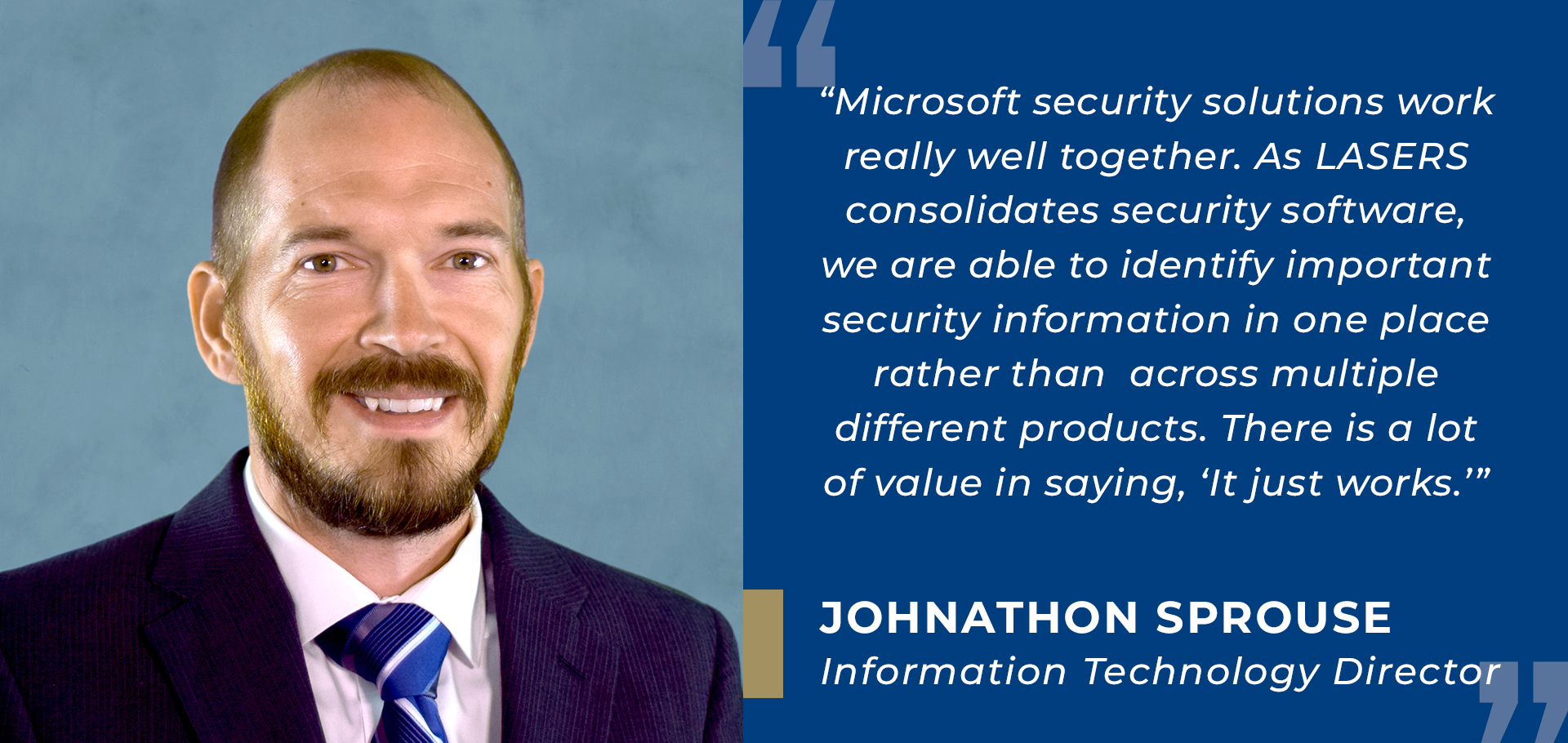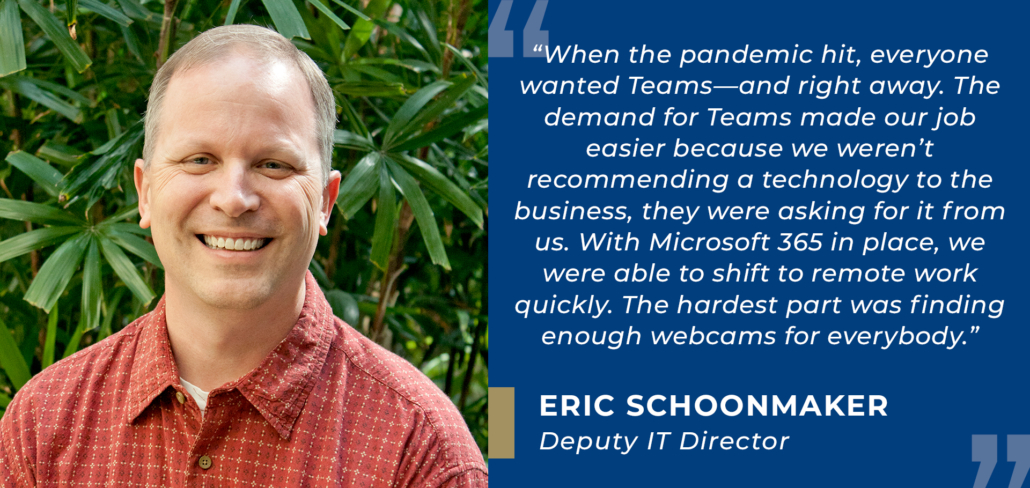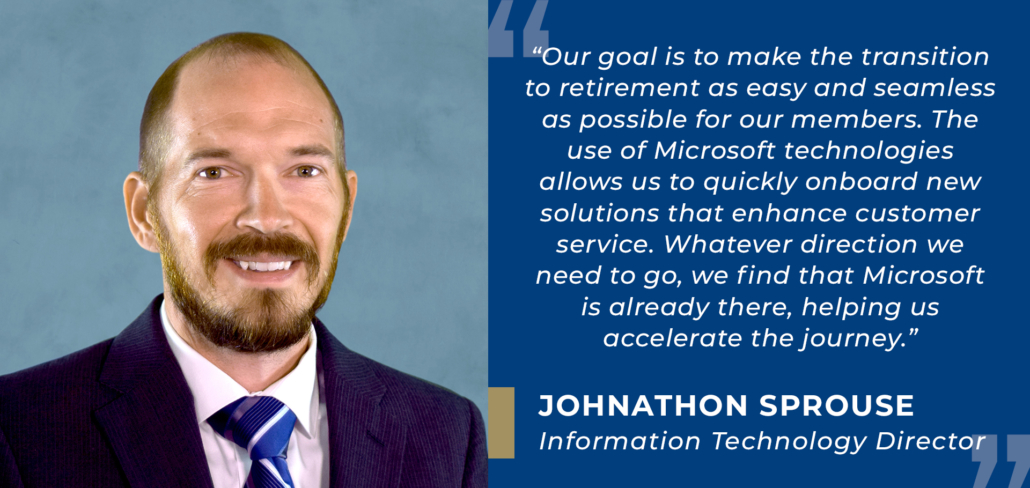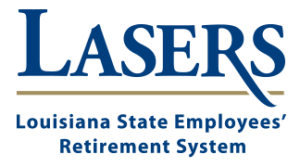The following customer story was written and published by Microsoft in July 2022.
 The Louisiana State Employees’ Retirement System (LASERS) provides benefits to state employees who have devoted their careers to public service. More than 100,000 members rely on the agency at critical moments throughout their careers—especially during the transition to retirement, a time of significant personal, financial, and social change.
The Louisiana State Employees’ Retirement System (LASERS) provides benefits to state employees who have devoted their careers to public service. More than 100,000 members rely on the agency at critical moments throughout their careers—especially during the transition to retirement, a time of significant personal, financial, and social change.
Technology leaders at LASERS take this responsibility seriously. Chief Technology Officer Johnathon Sprouse said, “Ensuring that we can deliver services securely while protecting member information is top priority, as well as speed of delivery, including the ability to leverage the cloud to meet customer expectations.”
To boost the pace of transformation, LASERS IT staff needed to free up time to focus on member-facing applications. While LASERS had made advancements to modernize its core member-facing application, myLASERS, the agency saw several opportunities to reduce administrative complexity while updating the tools employees use to collaborate and serve members. One way to accomplish that was to shed labor-intensive management of on-site email and identity services. Another involved unifying a security ecosystem, which had been built on a variety of different solutions, to reduce administrative complexity and improve visibility into mobile devices and emerging threats.
Liberating time and talent
It took persistence and vision to achieve these goals. The seeds of the modern collaboration and security capabilities LASERS has today were planted during a 2014 review of its technology ecosystem, which revealed the benefits of migrating to Microsoft 365 for cloud-based identity and email. The IT staff guided a thorough review of the technical capabilities and security of the solution, using the Microsoft Trust Center extensively to build buy-in and confidence among leadership. In 2019, they were approved to proceed. This began a journey of accelerated transformation that would ultimately lead to other improvements across LASERS.
The first step was to migrate identity services from an on-site Active Directory server to Azure Active Directory (Azure AD), which took about a week. “We initially needed to adopt Azure AD to support our migration to Microsoft 365 email, but it turned out to be more important than we knew at the time,” said Sprouse. “It supported seamless integration with other solutions down the road. As we onboard offerings from Microsoft and partners, Azure AD provides us with a single view of identity and an easy way to apply security best practices like multifactor authentication.”
The email migration quickly followed, taking about three months to finish. Once it was complete, the infrastructure team shut down the on-site email system with a sense of relief. Prior to adopting Microsoft 365, they updated the system manually—a stressful and time-consuming proposition. “Email is the most critical employee-facing application, and any downtime is highly noticeable,” said Greg Byrd, Infrastructure Manager at LASERS. “Previously, we tended to defer updates as long as possible because the cost was so high. It would take at least a couple of weeks just to prepare for an update. Moving from on-site Exchange to Microsoft 365 was like night and day. It eliminated all that extra work.” With Microsoft 365, Exchange is updated automatically, so Byrd and his team can empower LASERS employees with the latest email security and productivity features without spending months on every update.
They can also invest the time they save in building customer-facing experiences, especially for the myLASERS application which is hosted on-site. “Our mission is to provide a sound retirement plan for our members,” said Sprouse. “With Microsoft 365, our team focuses their time on new solutions that enhance customer service rather than maintaining existing software.”
Deploying Teams just in time

After experiencing the benefits of cloud-based email, the IT Division decided to explore the collaboration potential of Microsoft Teams. The IT Division initiated a small pilot program in late 2019, which turned out to be a prescient move. As Eric Schoonmaker, Deputy IT Director at LASERS, recalled, “When the pandemic hit, everyone wanted Teams—and right away. The demand for Teams made our job easier because we weren’t recommending a technology to the business, they were asking for it from us. With Microsoft 365 in place, we were able to shift to remote work quickly. The hardest part was finding enough webcams for everybody.”
Although LASERS has a strong culture of in-person collaboration, most employees also use Teams every day for voice and video meetings and team chat. For example, the Member Services Division collaborates on Teams to support myLASERS users, while the IT Division uses it to work closely with vendors and partners.
Sprouse has taken advantage of subscription-based licensing in Microsoft 365 to increase the value of technology investments for LASERS. “The fact that employees can install Microsoft Office on multiple devices, while ensuring compliance, is a great benefit of Microsoft 365, especially with the transition to hybrid work,” noted Sprouse. “It also includes a wide variety of products, so it’s a better value for LASERS.”
The strength of the Microsoft partner ecosystem also factors into the value equation. Using Azure AD, employees enjoy seamless, well-secured access to partner solutions. For example, LASERS partnered with Adobe Sign to capture digital signatures. Employees sign in using their LASERS account, and the Adobe product operates seamlessly with Teams and Office.
Simplifying security while improving protection
Parallel to ongoing improvements in collaboration and productivity tools, the IT Division continued driving security capabilities forward. Following the successful migration to Microsoft 365 and Teams, LASERS recognized the benefits of using security solutions included with the Microsoft 365 E5 license. This enabled LASERS to consolidate disparate tools onto a single platform, eliminating third-party licensing costs and simplifying security.
A pilot evaluation proved that Microsoft offerings met or exceeded the capabilities of the products LASERS was using at the time. The organization replaced third-party mobile device management and antivirus with Microsoft Intune and Microsoft Defender for Endpoint, and adopted Microsoft Defender for Identity to replace a previous-generation Microsoft product. “Microsoft security solutions work really well together,” said Sprouse. “As LASERS consolidates security software, we are able to identify important security information in one place rather than across multiple different products. There is a lot of value in saying, ‘It just works.’”
The agency rolled out Intune to all LASERS-issued mobile devices and laptops in 2022. It gave the IT team visibility into compliance and governance for all devices, together with the ability to detect those that are “jailbroken” or otherwise compromised. The new solution makes it easy to enforce policies such as strong passwords and multifactor authentication.
Replacing third-party antivirus with Defender for Endpoint in 2022 improved visibility and protection against new threats. “The alerts and incidents in Defender for Endpoint show us things we wouldn’t have seen before,” said Sprouse. “Because it’s a cloud-based system, Microsoft keeps it up-to-date faster than we ever could. When new threats emerge, we’re already protected and can monitor them in real time.”
Gaining room to grow
The team is just beginning to take advantage of all the capabilities now included with their security suite. For example, after rolling out antivirus capabilities in Defender for Endpoint, they started exploring its software inventory features. “We discovered that there’s a lot of room to grow into Microsoft security solutions and adopt additional functionality as we go,” said Sprouse. “We are confident there is a solution that addresses our needs, it works seamlessly with our current products, and we can decide when to use it.”
Throughout the process of security modernization, the IT staff received extensive support from Microsoft. Customer advisors from the Microsoft State and Local Government team helped them build a roadmap, and Microsoft FastTrack experts assisted with deployment, overcame technical challenges, and got the most from the organization’s technology investments. “We have weekly calls with our FastTrack consultants where they answer our technical and business questions about Microsoft solutions,” said Byrd. “This deep level of engagement is really helpful for the security professionals on our team.”
The steps taken by LASERS have enhanced customer service in several ways. With seamless collaboration in Microsoft Teams, employees work together more easily to solve customer challenges and respond to requests faster. Security-enabled hybrid work capabilities help them stay productive anywhere on behalf of members. Additionally, the IT team now has more time to focus on building new features in myLASERS and expanding the adoption of cloud solutions that support faster, more reliable services.
Looking ahead to an even more secure workplace

Despite the long list of wins achieved in a short time—during a pandemic, no less—Sprouse and his team are not pausing in their quest to improve customer service, employee productivity, and security at LASERS.
In terms of productivity and collaboration, they are looking to expand Microsoft SharePoint and Microsoft OneDrive access across LASERS based on the results of a pilot program. On the device management front, they are experimenting with Microsoft Endpoint Manager for in-depth control and governance of their entire device ecosystem, including desktops. They are also exploring Microsoft Sentinel as a replacement for their current on-site Security Incident and Event Management solution.
Ultimately, LASERS continues to make technology choices that empower employees to support customers more effectively. “Our goal is to make the transition to retirement as easy and seamless as possible for our members,” Sprouse concluded. “The utilization of Microsoft technologies allows us to quickly onboard new solutions that enhance customer service. Whatever direction we need to go, we find that Microsoft is already there, helping us accelerate the journey.”

